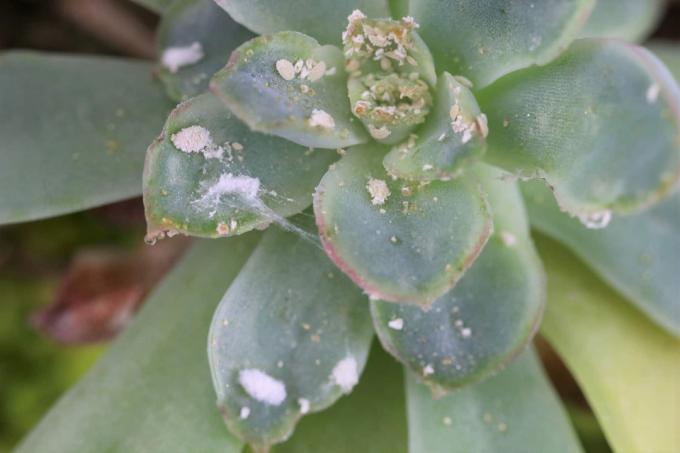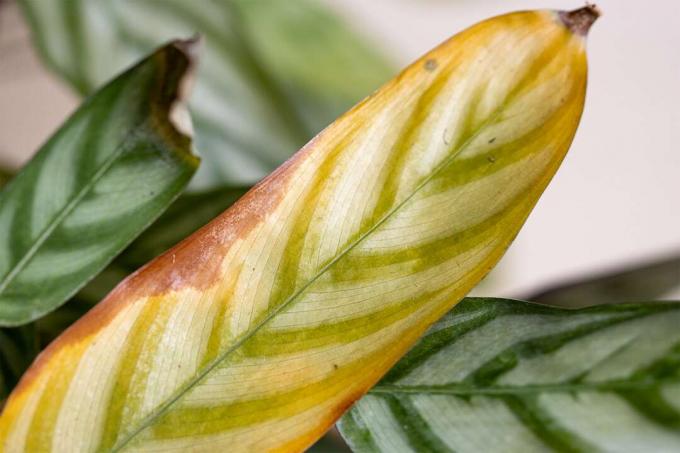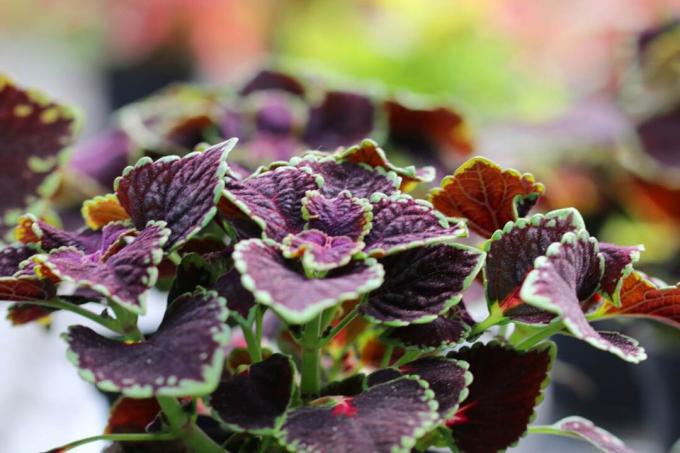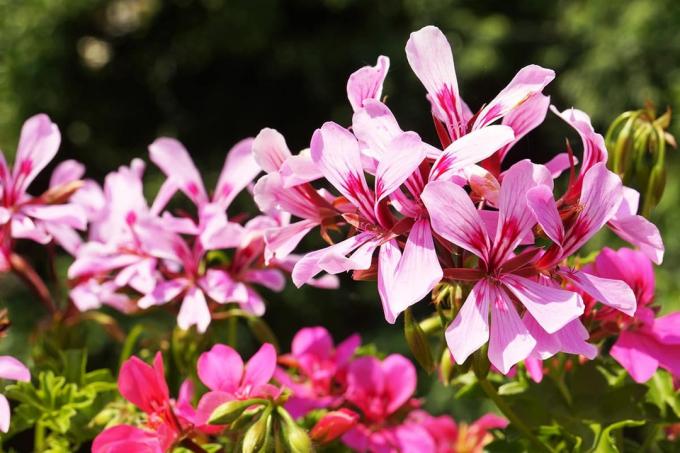

Table of contents
- Tips and help with the various pests
- white flies
- aphids
- Mealybugs or mealybugs
- mini flies
- scale insects
- Things worth knowing about pests on indoor plants
- Special: control of spider mites
In winter, there is now a particularly high risk that houseplants will be infested with aphids or spider mites. Bugs are no longer uncommon at this time of year. The pests eventually take full advantage of it and are very skilled.
They often grab potted plants in particular, which are weakened by the heating air and little light. The leaves turn yellow, curl up or even get holes. If this is the case, you simply have to act quickly so that the other plants are not infected.
The best-known houseplant pests are probably aphids. The infestation of a plant can be seen above all from the small, green animals that attack the shoots and leaves as colonies. The animals suck the sap from the plants and damage the plant parts. The sticky coating on the leaves comes from the sugary excretions of the aphids. Balcony and tub plants that are brought indoors in winter are particularly susceptible to these little animals.
Of course there are a number of pests that are typical of the different seasons. However, the means to combat them are different. With a few tips and tricks, however, anyone can get the pests under control and take care of their plants. There are even some home remedies that will help get rid of the pests quickly, leaving your plants healthy and beautiful.
Tips and help with the various pests
white flies
The symptoms of this pest are easy to spot. The leaves of the plant turn yellow and wither. In addition, they can dry out completely if the infestation is particularly severe. The little creatures are just 2 mm in size and are usually visible when the leaf of the plant is moved. The white larvae of the flies suck up the plant sap and secrete a sticky honeydew. Prevention: In order to be able to prevent whiteflies, it is important to avoid too dry and warm air in your plants. If, despite all this, the plant is infested, a special shine spray must be used so that the whiteflies can be combated.
aphids
The stunted growth, the curled leaves and above all the sucking of the plant sap. These are all signs of aphids. Prevention and control: Dry and warm air often lead to aphids. Despite all this, these can always be combated. With a rather low infestation, washing off the plant is often sufficient. However, if the infestation is worse, you can use plant sticks that are aimed directly at pest control. Aphid sprays, which can be found in any garden center, are also effective.
Mealybugs or mealybugs
If a plant is affected by these, the leaves will turn yellowish and puny after a while. The lice even affect the growth of the plant and form cotton-like and sticky structures, especially on the undersides of the leaves. These pests also suck up the plant sap. Prevention and control: As with all other pests, it is important that the room is not too dry and warm. After all, mealybugs are clearly visible. Accordingly, they can be removed directly from the plant with cotton or tweezers. A spirit soap solution can be helpful to finally fight them. Often even Australian ladybirds are used as beneficial insects.
mini flies
White lines on the leaves and yellowish colors on the undersides of the leaves. This often indicates the infestation of a mini fly. This pest even causes the leaves to die off over time. The eggs and maggots of this pest are very difficult to see. However, the flies can be spotted immediately. Prevention and control: The small flies can be removed directly with yellow boards or a vacuum cleaner. However, you should make sure that you fight the adult animals directly so that they can no longer lay eggs. The flies should therefore only be removed at the base of the leaves. Chemicals or even other beneficial insects are of little use against this pest.
scale insects
White brown caps can be found directly on the plant with this pest. A sticky coating is also present there. Gradually, the plant appears weakened because the lice suck the sap from the plant. Prevention and control: A balanced plant nutrition is very important so that no pests such as scale insects can form on the plant. If, despite all this, an infestation occurs, the plants should be isolated immediately. The shields should then be carefully removed with a knife and a spray used to remove the remaining pests from the plant. There are now also some pesticides that can more than help in this area.
Things worth knowing about pests on indoor plants
With just a few tips and help, it is no longer difficult to combat pests on houseplants these days. In most cases, home remedies or beneficial insects are the best way to save the plant from other pests. With a little caution and a good eye, a plant no longer has to suffer from pests. A houseplant that is in an optimal spot and watered properly is for most pests a tough nut to crack! Unfortunately they will indoor plants but still like im Summer poured... this means that the plants are often very wet or the exact opposite, too dry! This will weaken the plants quite a bit. In this state they are very susceptible to pests such as spider mites, aphids and lacewings:
- If these pests have spread, you should take the infested houseplant out of the pot, ...
- … rinse them off carefully with mild soapy water
- ... and pot them fresh again in another pot filled with good potting soil.
- Clean the old pot well with soapy water and let it dry.
- Place the repotted plant in a bright spot that is not too cool or too warm.
- East or north windows would be good. Water briefly and water once a week.
- As soon as the sun shines more strongly, water the plants two to three times a week and once a week fertilize.
- It is best to put your index finger briefly in the pot with the soil and try how moist the soil feels.
- The earth must not be wet - except for papyrus, this plant can stand in water.
- Continue to observe the newly potted plant and, if necessary, wipe it again carefully with soapy water.
Special: control of spider mites
Spider mites mainly appear on indoor plants in the winter months. These insects can only survive in relatively dry air and therefore find ideal conditions in heated living spaces where the air dries out easily from the heating.
There are hundreds of different types of spider mites, but hobby gardeners have to struggle with the common spider mite in particular. It only grows about half a millimeter in size and is therefore difficult to spot. However, an infestation can be recognized by the light spots on the leaves, which are caused by the sucking activity of the insects. Like aphids, spider mites suck the sap from the leaves and thereby damage the plant. In addition, fine cobwebs can appear. The easiest way to combat spider mites is to increase the humidity. You also make life difficult for them by regularly spraying the leaves of the plants.
If the infestation is already quite large, the entire plant can simply be showered off. She is then placed in a large plastic bag and tied at the top. A high level of humidity develops inside the bag. It not only ensures that the adult insects die off, but also that subsequent generations die as soon as they hatch from the eggs. For this treatment, however, the plant must remain in the bag for a few days.
Sprays from the garden center also bring good results. They are made on the basis of various substances. However, their natural enemies are also suitable for combating spider mites. These include:
- lacewings
- predatory mites
- ladybug
- parasitic wasps
These insects their eggs or larvae are also commercially available and are mainly used in greenhouses and larger conservatories.
 garden editorial
garden editorial I write about everything that interests me in my garden.
Learn more about houseplants

Calathea has yellow leaves: how to save?
When a Coriander (Calathea) gets yellow leaves, the cause is usually a lack of care. In order to save them from dying, a number of countermeasures must be taken, which are described in detail here.

Room bamboo: 13 tips for care
The room bamboo impresses with its compact growth habit and is a densely grown houseplant. The ten most important tips for caring for the sweet grass are compiled for you here.

Coleus blumei: 21 tips for the red nettle
The colored nettle is a warmth-loving and easy-care foliage plant. The coloring of the leaves varies from monochromatic to variegated with a wide variety of drawings. Spectacular splashes of color can be set in beds, balcony boxes and tubs or as a houseplant.

Scented houseplants: 25 scented plants for the home
An apartment without indoor plants is hardly conceivable. Scented plants in particular have a very special effect. Not only are they decorative, they can lighten the mood and rival any artificial home fragrance.

Lucky chestnut, Pachira aquatica: care from A to Z
The care of the lucky chestnut does not require any special expertise. However, if you know the way of life of this ornamental plant, you can better adapt site conditions and care measures to your needs. The plant can be easily propagated if a plant already exists.

Rubber tree: 13 care tips for Ficus elastica
The rubber tree is one of the most popular indoor plants. It is available in different varieties, easy to care for and stands out for its large leaves, which are colored in intense shades of green. Within a few years, it grows into a state small tree without much effort.


